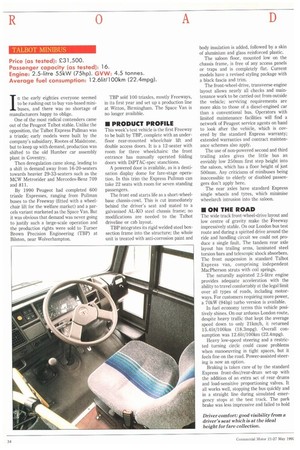TALBOT MINIBUS
Page 36

If you've noticed an error in this article please click here to report it so we can fix it.
Price (as tested): £31,500.
Passenger capacity (as tested): 16.
Engine: 2.5-litre 55kW (75hp). GVW: 4.5 tonnes. Average fuel consumption: 12.614/100km (22.4mpg).
In the early eighties everyone seemed to be rushing out to buy van-based minibuses, and there was no shortage of manufacturers happy to oblige.
One of the most radical contenders came out of the Peugeot Talbot stable. Unlike the opposition, the Talbot Express Pullman was a triaxle; early models were built by the company's subsidiary, Rootes of Maidstone, but to keep up with demand, production was shifted to the old Humber car assembly plant in Coventry.
Then deregulation came along, leading to a shift in demand away from 16-20-seaters towards heavier 29-33-seaters such as the MCW Metrorider and Mercedes-Benz 709 and 811.
By 1990 Peugeot had completed 600 triaxle Expresses, ranging from Pullman buses to the Freeway (fitted with a wheelchair lift for the welfare market) and a parcels variant marketed as the Space Van. But it was obvious that demand was never going to justify such a large-scale operation and the production rights were sold to Turner Brown Precision Engineering (TBP) at Bilston, near Wolverhampton. TBP sold 100 trimdes, mostly Freeways, in its first year and set up a production line at Witton, Birmingham, The Space Van is no longer available.
• PRODUCT PROFILE
This week's test vehicle is the first Freeway to be built by TBP, complete with an underfloor rear-mounted wheelchair lift and double access doors. It is a 12-seater with room for three wheelchairs: the front entrance has manually operated folding doors with DiPTAC-spec stanchions.
A powered door is available, as is a destination display dome for fare-stage operation. In this trim the Express Pullman can take 22 seats with room for seven standing passengers.
The front end starts life as a short-wheelbase chassis-cowl. This is cut immediately behind the driver's seat and mated to a galvanised AL-K0 steel chassis frame; no modifications are needed to the Talbot driveline or cab layout.
TBP integrates its rigid welded steel boxsection frame into the structure; the whole unit is treated with anti-corrosion paint and body insulation is added, followed by a skin of aluminium and glass reinforced plastic.
The saloon floor, mounted low on the chassis frame, is free of any access panels or traps and is completely flat. Current models have a revised styling package with a black fascia and trim.
The front-wheel-drive, transverse engine layout allows nearly all checks and maintenance work to be carried out from outside the vehicle; servicing requirements are more akin to those of a diesel-engined car than a conventional bus. Operators with limited maintenance facilities will find a network of Peugeot service agents on hand to look after the vehicle, which is covered by the standard Express warranty; extended warranties and contract maintenance schemes also apply.
The use of non-powered second and third trailing axles gives the little bus an enviably low 250mm first step height into the saloon, which has a floor height of just 500mm. Any criticisms of minibuses being inaccessible to elderly or disabled passengers don't apply here.
The rear axles have standard Express single wheels and tyres, which minimise wheelarch intrusion into the saloon.
• ON THE ROAD
The wide track front-wheel-drive layout and low centre of gravity make the Freeway impressively stable. On our London bus test route and during a spirited drive around the ride and handling circuit we could not produce a single fault. The tandem rear axle layout has trailing arms, laminated steel torsion bars and telescopic shock absorbers, The front suspension is standard Talbot Express van, comprising independent MacPherson struts with coil springs.
The naturally aspirated 2.5-litre engine provides adequate acceleration with the ability to travel comfortably at the legal limit over all types of roads, including motorways. For customers requiring more power, a 70kW (94hp) turbo version is available.
In fuel economy terms this vehicle positively shines. On our arduous London route, despite heavy traffic that kept the average speed down to only 21km/h, it returned 15.41it/100km (18.3mpg). Overall consumption was 12.61it/100km (22.4mpg).
Heavy low-speed steering and a restricted turning circle could cause problems when manoeuvring in tight spaces, but it feels fine on the road. Power-assisted steering is now an option.
Braking is taken care of by the standard Express front-disc/rear-drum set-up with the addition of an extra set of rear drums and load-sensitive proportioning valves. It all works well, stopping the bus quickly and in a straight line during simulated emergency stops at the test track. The park brake was less impressive and failed to hold Driver comfort: good visibility from a driver's seat which is at the ideal height for fare collection.




























































































